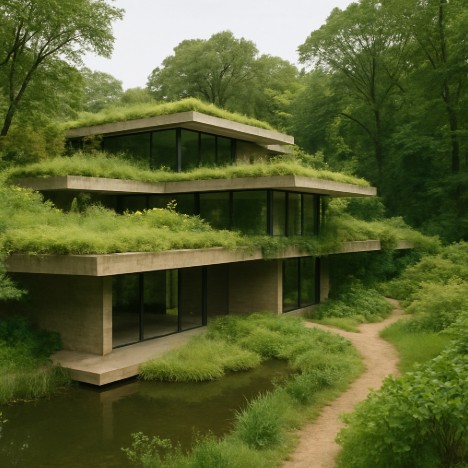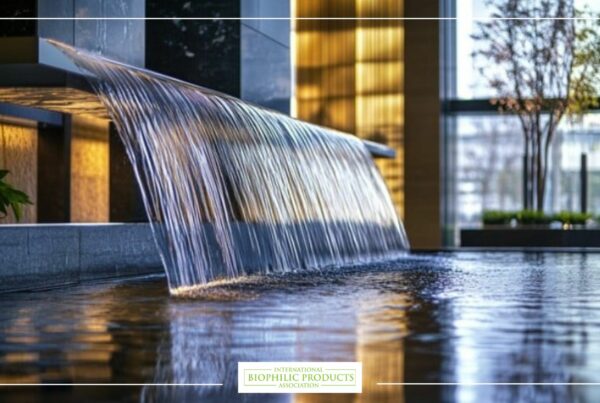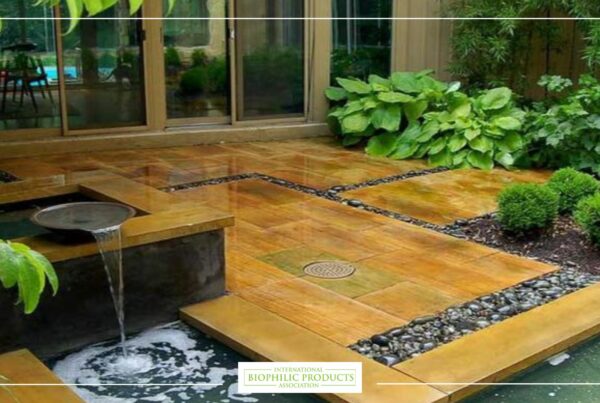Organic architecture is gaining momentum as environmental awareness increases globally. Architects, designers, and builders are recognizing the importance of creating spaces that not only fulfill human needs but also respect the planet. This growing awareness reflects a broader shift in society towards sustainability and environmental stewardship. As a result, organic architecture is emerging as a viable solution to address the pressing issues of climate change, resource depletion, and urbanization, offering a path towards a more sustainable and harmonious future.

Organic architecture is a philosophy of architecture which promotes harmony between human habitation and the natural world. This is achieved through design approaches that integrate the building with its environment. The goal is to create spaces that are not only functional but also enhance the well-being of their inhabitants. Organic architecture seeks to minimize the boundary between the indoor and outdoor environments, often blurring the lines between nature and structure. This approach not only enhances the aesthetic appeal of a building but also creates a more comfortable and healthier living environment.
Key characteristics of organic architecture
Organic architecture is characterized by several key principles:
- Integration with Nature: Buildings are designed to be in harmony with their surroundings, often by using natural materials and incorporating landscape features. This integration can involve designing buildings that mimic natural forms or that are situated to maximize natural light and views. By doing so, architects create spaces that feel like a natural extension of their environment, fostering a sense of tranquility and connection with nature.
- Sustainability: Emphasizes the use of sustainable materials and energy-efficient systems to minimize environmental impact. Sustainable practices in organic architecture go beyond just material selection; they also consider the building’s lifecycle, from construction to demolition. This holistic approach ensures that the building’s environmental footprint is minimized, contributing to broader efforts to combat climate change.
- Biophilic Design: This involves incorporating elements of nature into the built environment, such as natural light, plants, and water features. Biophilic design is not only about aesthetics; it also has proven benefits for human health and well-being. Studies have shown that exposure to natural elements can reduce stress, improve mood, and enhance cognitive function, making biophilic design a valuable component of organic architecture.
- Flexibility and Adaptability: Structures are designed to adapt to the changing needs of their inhabitants over time. This adaptability ensures that buildings remain functional and relevant, reducing the need for extensive renovations or replacements. By designing spaces that can evolve with their users, architects create buildings that are not only sustainable but also resilient in the face of changing societal and environmental conditions.
- Aesthetic Harmony: The design is visually pleasing and often reflects the natural forms and colors found in the surrounding environment. Aesthetic harmony in organic architecture is about more than just visual appeal; it’s about creating a sense of place and belonging. By reflecting the beauty of the natural world, organic architecture fosters a deeper connection between people and their environment, enhancing the overall quality of life.
The roots of organic architecture

The concept of organic architecture was popularized by the renowned architect Frank Lloyd Wright. He believed that architecture should be a part of the environment and not impose itself on it. Wright’s designs, such as the famous Fallingwater house, exemplify the principles of organic architecture by blending seamlessly with their natural surroundings. His work demonstrated that buildings could be both functional and beautiful, challenging the rigid, industrialized approach to architecture that dominated the early 20th century.
Wright was influenced by the Arts and Crafts movement, which emphasized handcrafted details and the use of local materials. He also drew inspiration from nature itself, believing that a building should appear as though it naturally belongs in its location. This philosophy led him to develop designs that were innovative yet grounded in the natural world. Wright’s legacy continues to inspire architects today, encouraging them to explore new ways of integrating nature into their designs.
The principles of organic architecture extend beyond Wright’s work, drawing on ideas from other architectural movements and philosophies. For instance, the concept of “form follows function,” popularized by the Bauhaus school, aligns with organic architecture’s emphasis on creating spaces that serve the needs of their users. Similarly, the environmental consciousness of the 1960s and 1970s has informed the sustainable practices integral to organic architecture. By combining these diverse influences, organic architecture offers a holistic approach to building design that is both innovative and respectful of the natural world.
The role of green building in organic architecture
Green building practices are a cornerstone of organic architecture. These practices focus on reducing the environmental impact of buildings through energy efficiency, sustainable materials, and smart design. By incorporating green building principles, organic architecture not only minimizes its ecological footprint but also creates healthier and more comfortable living environments. These practices are essential for addressing the environmental challenges we face today, offering practical solutions for reducing carbon emissions and conserving natural resources.
Key aspects of green building
- Energy Efficiency: Incorporating systems that reduce energy consumption, such as solar panels and energy-efficient appliances. Energy efficiency is a critical component of green building, helping to reduce reliance on fossil fuels and lower utility bills. By utilizing passive design strategies, such as orientation and insulation, architects can significantly decrease a building’s energy needs, contributing to a more sustainable future.
- Sustainable Materials: Using materials that are renewable, recycled, or have a low environmental impact. The selection of sustainable materials is crucial for reducing the environmental footprint of a building. By choosing locally sourced and non-toxic materials, architects can minimize transportation emissions and create healthier indoor environments, supporting both environmental and human health.
- Water Conservation: Implementing systems to reduce water usage and recycle greywater. Water conservation is an essential aspect of green building, particularly in regions facing water scarcity. By incorporating rainwater harvesting, low-flow fixtures, and efficient irrigation systems, architects can significantly reduce water consumption and promote responsible water management.
- Indoor Environmental Quality: Ensuring good air quality, natural lighting, and acoustics to enhance the health and comfort of occupants. Indoor environmental quality is a critical factor in determining the overall well-being of building occupants. By prioritizing natural light, ventilation, and sound insulation, architects can create spaces that are not only comfortable but also conducive to health and productivity.
Biophilic design: bringing nature indoors

Biophilic design is a key component of organic architecture. It refers to the practice of connecting building occupants more closely to nature. Studies have shown that biophilic design can improve mental health, boost productivity, and enhance overall well-being. By integrating natural elements into the built environment, architects create spaces that are not only aesthetically pleasing but also supportive of human health and happiness.
Elements of biophilic design
- Natural Light: Maximizing the use of windows and skylights to bring in natural light. Natural light is a fundamental aspect of biophilic design, offering numerous benefits for physical and mental health. By designing spaces that prioritize natural light, architects can reduce reliance on artificial lighting and create more inviting and energizing environments.
- Indoor Plants: Incorporating greenery into interior spaces. The presence of indoor plants has been shown to reduce stress, improve air quality, and enhance mood. By integrating plants into the design of a building, architects can create spaces that feel vibrant and alive, fostering a sense of connection with nature.
- Natural Materials: Using wood, stone, and other natural materials in the design. Natural materials not only enhance the aesthetic appeal of a space but also provide tactile and sensory experiences that are often lacking in synthetic environments. By incorporating these materials, architects can create spaces that feel warm and inviting, promoting a sense of well-being.
- Water Features: Including elements like fountains or aquariums to create a calming environment. Water features are a powerful tool in biophilic design, offering visual and auditory stimuli that can reduce stress and promote relaxation. By incorporating water into the design of a building, architects can create tranquil and restorative environments that support mental health and well-being.
Benefits of organic architecture
Organic architecture offers numerous benefits, both for individuals and the environment. By prioritizing sustainability, health, and aesthetics, organic architecture creates spaces that are not only functional but also enriching and inspiring.
Environmental benefits
- Reduced Carbon Footprint: By using sustainable materials and energy-efficient systems, organic architecture helps reduce the carbon footprint of buildings. This reduction is crucial for mitigating climate change and promoting a more sustainable future. By minimizing energy consumption and utilizing renewable resources, organic architecture supports global efforts to reduce greenhouse gas emissions.
- Biodiversity Support: Integrating green spaces and natural habitats into building design supports local biodiversity. By creating habitats for plants and animals, organic architecture contributes to the preservation of ecosystems and enhances the resilience of urban environments. This integration not only benefits wildlife but also enriches the human experience, providing opportunities for recreation and education.
- Resource Conservation: Efficient use of materials and energy reduces waste and conserves natural resources. By prioritizing resource conservation, organic architecture promotes a more sustainable and responsible approach to building design. This commitment to conservation supports broader efforts to protect the planet’s finite resources and ensure a sustainable future for generations to come.
Human benefits
- Improved Health and Well-being: Exposure to natural elements and better indoor air quality can lead to improved physical and mental health. By creating environments that prioritize health and well-being, organic architecture enhances the quality of life for its occupants. This focus on well-being supports a more balanced and fulfilling lifestyle, promoting both individual and community health.
- Increased Productivity: Natural light and biophilic elements have been shown to boost concentration and productivity. By creating spaces that support focus and creativity, organic architecture contributes to a more effective and satisfying work environment. This increase in productivity not only benefits individuals but also supports organizational success and growth.
- Enhanced Aesthetic Appeal: The integration of nature into design creates visually pleasing environments that enhance quality of life. By prioritizing aesthetics, organic architecture fosters a sense of joy and inspiration, enriching the human experience. This emphasis on beauty and harmony supports a more vibrant and connected community, promoting a sense of pride and belonging.
Challenges in implementing organic architecture
While organic architecture offers many benefits, it also presents some challenges. These challenges must be addressed to fully realize the potential of organic architecture and promote its adoption on a wider scale.
Cost
One of the main challenges is cost. Sustainable materials and energy-efficient systems can be more expensive upfront. However, they often lead to cost savings over the long term through reduced energy bills and maintenance costs. By investing in quality materials and systems, developers can create buildings that are not only more sustainable but also more durable and cost-effective in the long run.
The perception of higher costs can be a barrier to the adoption of organic architecture, particularly for developers and homeowners with limited budgets. Educating stakeholders about the long-term financial benefits of sustainable design can help overcome this challenge, promoting a more informed and balanced approach to building development.
Design complexity
Designing buildings that truly integrate with their surroundings requires a high level of creativity and expertise. It often involves complex design processes and the collaboration of various professionals. This complexity can be a barrier to the adoption of organic architecture, particularly for smaller firms or projects with limited resources.
To address this challenge, architects and designers must embrace innovation and collaboration, seeking out new tools and technologies that support the integration of nature into design. By fostering a culture of creativity and experimentation, the architectural community can overcome the complexities of organic architecture and unlock its full potential.
Regulatory hurdles
In some regions, building codes and regulations may not yet accommodate the innovative approaches used in organic architecture, making it challenging to get projects approved. These regulatory hurdles can slow the adoption of organic architecture and limit its impact on the built environment.
To address this challenge, architects and advocates must work with policymakers to update building codes and regulations, ensuring that they support sustainable and innovative design. By promoting awareness and understanding of the benefits of organic architecture, the architectural community can help drive regulatory change and support a more sustainable future.
The future of organic architecture
The future of organic architecture is promising. As awareness of environmental issues grows, more people are seeking out sustainable and harmonious living spaces. Advances in technology and materials are also making it easier to implement organic design principles. These advancements are paving the way for a new era of architecture, one that prioritizes sustainability, health, and well-being.
Architects and builders are increasingly embracing the concepts of organic architecture to create buildings that are not only functional but also enhance the well-being of their inhabitants and the environment. By integrating nature into design, architects can create spaces that inspire and uplift, supporting a more sustainable and harmonious world.
The future of organic architecture lies in its ability to adapt and evolve, responding to the changing needs of society and the environment. By embracing innovation and collaboration, the architectural community can continue to push the boundaries of what is possible, creating a built environment that is truly in harmony with nature.
Organic architecture represents a shift towards more sustainable and harmonious building practices. By integrating nature into design, using sustainable materials, and focusing on the well-being of occupants, organic architecture offers a blueprint for the future of building design. As we continue to face environmental challenges, the principles of organic architecture offer valuable solutions for creating a more sustainable and connected world.
Understanding and accepting these concepts allows us to design environments that not only meet our needs but also benefit the natural world around us. As architects, builders, and inhabitants, we have the power to shape the future of our built environment, creating a legacy of sustainability and harmony for generations to come.











13 Comments